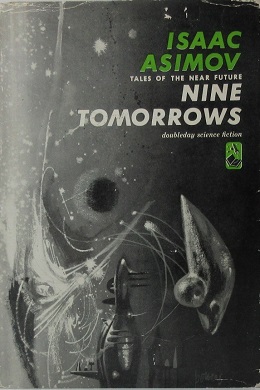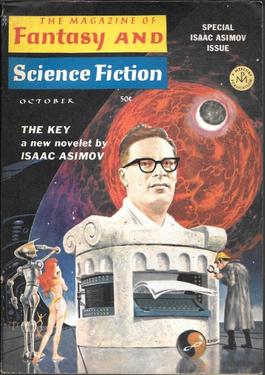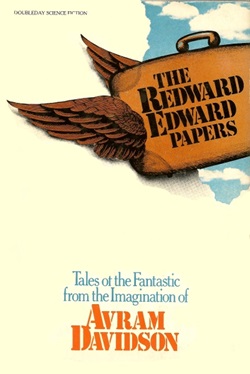
Dangerous Visions is an anthology of science fiction short stories edited by American writer Harlan Ellison and illustrated by Leo and Diane Dillon. It was published in 1967 and contained 33 stories, none of which had been previously published.

Lester del Rey was an American science fiction author and editor. He was the author of many books in the juvenile Winston Science Fiction series, and the editor at Del Rey Books, the fantasy and science fiction imprint of Ballantine Books, along with his fourth wife Judy-Lynn del Rey.

Earth Is Room Enough is a collection of fifteen short science fiction and fantasy stories and two pieces of comic verse by American writer Isaac Asimov, published in 1957. In his autobiography In Joy Still Felt, Asimov wrote, "I was still thinking of the remarks of reviewers such as George O. Smith... concerning my penchant for wandering over the Galaxy. I therefore picked stories that took place on Earth and called the book Earth Is Room Enough." The collection includes one story from the Robot series and four stories that feature or mention the fictional computer Multivac.

The Rest of the Robots is a collection of eight short stories and two full-length novels by American writer Isaac Asimov, published in 1964. The stories, centred on positronic robots, are all part of the Robot series, most of which take place in the Foundation universe. Another collection of short stories about robots, I, Robot, was re-published in the previous year, which is why Asimov chose to title the collection as The Rest of the Robots. None of the short stories in this collection were in I, Robot, however all of them were later included in The Complete Robot, and both novels about Elijah Baley were also published separately.

Nine Tomorrows is a collection of nine short stories and two pieces of comic verse by American writer Isaac Asimov. The pieces were all originally published in magazines between 1956 and 1958, with the exception of the closing poem, "Rejection Slips", which was original to the collection. The book was first published in the United States in 1959 and in the UK in 1963. It includes two of Asimov's favorite stories, "The Last Question" and "The Ugly Little Boy".

The Best of Isaac Asimov is a collection of twelve science fiction short stories by American writer Isaac Asimov, published by Sphere in 1973. It begins with a short introduction giving various details on the stories, such as how they came to be written, or what significance merits their inclusion in a "best of" collection, as well as some of Dr. Asimov's thoughts on a best of collection itself. The stories included are two of his early works, two of his late works (post-1960), and eight from the 1950s, which he refers to as his "golden decade" in the introduction. Except for the last story in the book, "Mirror Image", none of the stories are related to his Robot and Foundation series, while a few mention the Multivac computer.

Nightfall and Other Stories (1969) is a collection of 20 previously published science fiction short stories by Isaac Asimov. Asimov added a brief introduction to each story, explaining some aspect of the story's history and/or how it came to be written.

"Marooned off Vesta" is a science fiction short story by American writer Isaac Asimov. It was the third story he wrote, and the first to be published. Written in July 1938 when Asimov was 18, it was rejected by Astounding Science Fiction in August, then accepted in October by Amazing Stories, appearing in the March 1939 issue. Asimov first included it in his 1968 story collection Asimov's Mysteries, and subsequently in the 1973 collection The Best of Isaac Asimov.
"The Dying Night" is a science fiction short story by American writer Isaac Asimov. The story first appeared in the July 1956 issue of The Magazine of Fantasy & Science Fiction, and was reprinted in the collections Nine Tomorrows (1959), Asimov's Mysteries (1968), and The Best of Isaac Asimov (1973). "The Dying Night" is Asimov's third Wendell Urth story.

"Anniversary" is a science fiction short story by American writer Isaac Asimov. It was first published in the March 1959 issue of Amazing Stories and subsequently appeared in the collections Asimov's Mysteries (1968) and The Best of Isaac Asimov (1973).
The Golden Age of Science Fiction, often identified in the United States as the years 1938–1946, was a period in which a number of foundational works of science fiction literature appeared. In the history of science fiction, the Golden Age follows the "pulp era" of the 1920s and 1930s, and precedes New Wave science fiction of the 1960s and 1970s. The 1950s are, in this scheme, a transitional period. Robert Silverberg, who came of age then, saw the 1950s as the true Golden Age.
"The Singing Bell" is a science fiction mystery short story by American writer Isaac Asimov, which first appeared in the January 1955 issue of The Magazine of Fantasy and Science Fiction and was reprinted in the 1968 collection Asimov's Mysteries. "The Singing Bell" was the first of Asimov's Wendell Urth stories.
"The Talking Stone" is a science fiction mystery short story by American writer Isaac Asimov, which first appeared in the October 1955 issue of The Magazine of Fantasy and Science Fiction and was reprinted in the 1968 collection Asimov's Mysteries. "The Talking Stone" was the second of Asimov's Wendell Urth stories.
"The Dust of Death" is a science fiction/mystery short story by American writer Isaac Asimov, first published in the January 1957 issue of Venture Science Fiction Magazine and reprinted in the 1968 collection Asimov's Mysteries.

Science Fiction Inventions is a reprint anthology of science fiction stories, edited by Damon Knight and published by Lancer Books as an original paperback in 1967.

The Asimov Chronicles: Fifty Years of Isaac Asimov is a collection of forty eight short science fiction and mystery stories and two science essays by American writer Isaac Asimov, published by Dark Harvest in May 1989.

"The Key" is a science fiction mystery novelette by American writer Isaac Asimov. It is one of the stories featuring the reclusive scientist Wendell Urth. It first appeared in The Magazine of Fantasy & Science Fiction in October 1966, and was reprinted in the anthologies Asimov's Mysteries (1968) and The Best Mysteries of Isaac Asimov (1986).

Nebula Awards 22 is an anthology of award winning science fiction short works edited by George Zebrowski, the third of three successive volumes under his editorship. It was first published in hardcover and trade paperback by Harcourt Brace Jovanovich in April 1988.
Depending on the counting convention used, and including all titles, charts, and edited collections, there may be currently over 500 books in Isaac Asimov's bibliography—as well as his individual short stories, individual essays, and criticism. For his 100th, 200th, and 300th books, Asimov published Opus 100 (1969), Opus 200 (1979), and Opus 300 (1984), celebrating his writing.

The Redward Edward Papers is a collection of science fiction and fantasy short stories, written by American author Avram Davidson and edited by Michael Kurland. It was first published in hardcover by Doubleday in July 1978. An ebook edition was issued by Gateway/Orion in August 2013. The collection has been translated into French.













